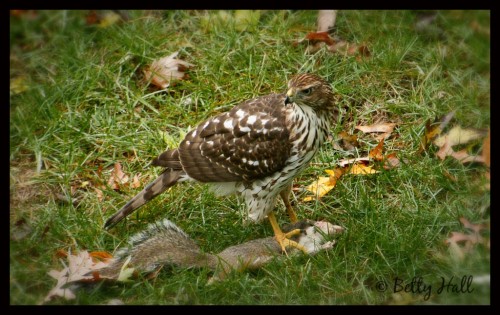In last week’s post, “Life and death in the backyard,” Harry and I thought the bird we’d seen was a red-shouldered hawk (Buteo lineatus). However, we were not certain and I invited other ideas. Thanks to the comments of excellent birders, we are now convinced that it was a Cooper’s hawk (Accipiter cooperi).
 Identifying hawks, especially immature ones, can be quite challenging. We’ve seen Cooper’s hawks several times in the backyard. However, this one seemed larger than the others, and previous hawks have fed on birds and seemed uninterested in squirrels.
Identifying hawks, especially immature ones, can be quite challenging. We’ve seen Cooper’s hawks several times in the backyard. However, this one seemed larger than the others, and previous hawks have fed on birds and seemed uninterested in squirrels.
I’ve now learned that most hawks are classified as buteos or accipiters. Buteos, which include red-shouldered hawks, are short-tailed and long-winged. In contrast, accipiters such as Cooper’s hawks are long-tailed and short-winged. These characteristics were a major factor in identifying our hawk.
I appreciate the comments from Ann Bowe and her Canadian brother and sister, Mike and Karen Ferguson; Jim McCormac; and Jannine Baker. Thanks to all for a great learning experience.


In addition to enjoying your wonderful photos, Betty, I always learn something from your postings. Love the hawk picture!
Thanks, Patsy. There’s no end to the learning, is there? However, I find it fun to think I’ve found one more piece of the ‘big’ puzzle.
This was great fun. My siblings enjoyed the challenge, I learned a lot, and it was wonderful to have Jim McCormac’s stamp of approval on the immature Cooper’s Hawk identification, and Jannine Baker’s, too. I have since enjoyed reading about how agile accipiters are, due to their long tail and short wings. They can maneuver through tree branches when going after their prey. A buteo is a soaring hawk and is not nearly so agile. Thanks so much for posting your excellent photo, Betty.
Thanks, Ann, for expanding on the value of short wings vs long wings. And another big thanks for giving us the advantage of your brother, sister, and Jim McCormac’s extensive knowledge about birds.
This is a juvenille northern goshawk. I have been observing coopers hawks and squirrels in my back yard for years and I can tell you that they are simply not that big. VERY, very highly unlikely to ever see one with a squirrel, let alone a juvenille coopers hawk. I know this is an old picture and thread but still think it should be corrected. People shouldn’t be out there thinking they eat squirrels. Unless this is a baby squirrel? lol I doubt that. It is a Goshawk!!
Thanks for your comment, Jeff. After looking at the Cornell Lab website, I’m still prone to think it was a Cooper’s Hawk: http://www.allaboutbirds.org/guide/coopers_hawk/lifehistory. While it says they mostly eat other birds, the section on food says they eat squirrels, too. Furthermore, northern goshawks are not at all common in our area. Guess we will never know for certain.